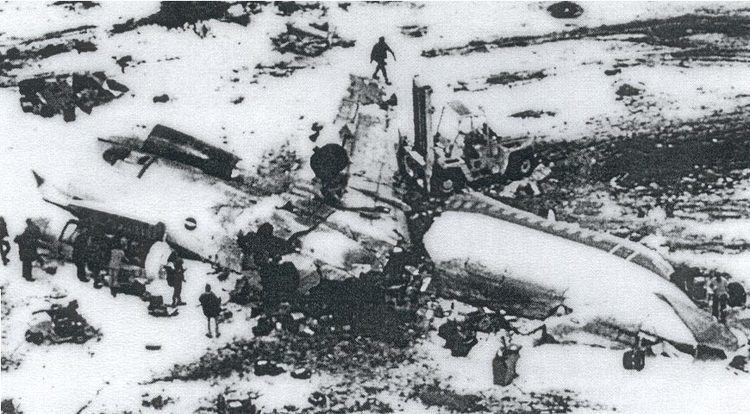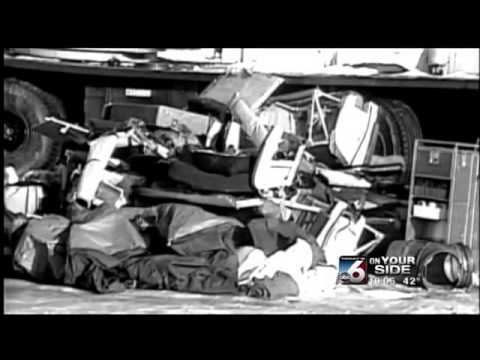Survivors 54 Registration N626TX Injuries (nonfatal) 28 Survivor 54 | Date 15 November 1987 | |
 | ||
Total fatalities 28 (25 passengers, 3 crew) Similar United Airlines Flight 859, United Airlines Flight 615, Continental Airlines Flight 1883, United Airlines Flight 2860, United Airlines Flight 610 | ||
Continental Airlines Flight 1713 was a commercial airline flight which crashed while taking off in a snowstorm from Stapleton International Airport in Denver, Colorado on November 15, 1987. The Douglas DC-9 was operated by Continental Airlines and was a scheduled flight to Boise, Idaho. Twenty-five passengers and three crew members died in the crash.
Contents
Aircraft

Flight 1713 was operated using a McDonnell Douglas DC-9-14, a twin-engine, narrow-body jet airliner (registration number N626TX). The aircraft was equipped with two Pratt & Whitney JT8D-7B engines. It was originally delivered to Air Canada in 1966, and sold to Continental in 1982. The airplane had accumulated 52,424 flight hours at the time of the accident.
Weather

At the time of the accident, the National Weather Service was reporting moderate wet snow at Stapleton International Airport. The heaviest snowfall rate occurred between 13:10 and 14:20 MST, with peak snowfall rate occurring around 13:50.
Accident

Continental Airlines Flight 1713 was scheduled to depart Denver at 12:25, but many flights out of Denver that day were delayed by inclement weather. At 13:03, Flight 1713 taxied from its gate to the deicing pad; air traffic controllers were not aware that Flight 1713 had departed the gate because the flight crew did so without requesting taxi clearance. Deicing was completed at 13:46. At 13:51, Flight 1713 contacted the clearance delivery controller for permission to "taxi from the ice pad." The clearance delivery controller, believing that Flight 1713 was still at the gate and requesting to proceed to deicing, instructed the flight to switch to ground controller frequency. Ground controllers then cleared Flight 1713 to taxi to the deicing pad. Flight 1713, already at the deice pad, taxied from the pad to hold at the end of runway 35L and await takeoff clearance. At 14:05, Flight 1713 was lined up on the number one position at the north end of the runway, and the crew was ready for take off. After several minutes of holding without receiving takeoff clearance, Flight 1713 notified air traffic controllers that they were holding and awaiting takeoff instructions.
Flight 1713 was cleared for takeoff at 14:14. As the plane was taking off, it over-rotated; the aircraft descended and the left wing struck the ground, causing the wing to separate. A fuel-fed flash fire ignited in the left wing shortly after it struck the ground, causing a "fireball" inside the cabin. The left side of the plane and cockpit struck the ground next and the plane continued rolling, inverted. As the plane skidded, the left side was tilted over and the tail was inverted; this action caused the middle part of the plane to compress and crush many of the passengers on board. Fitzsimmons Army Medical Facility sent its personnel to assist in the triage of passengers.

A total of 25 passengers and 3 crew members died in the crash. The captain and first officer, one flight attendant, and 11 passengers died from blunt trauma. In addition, 5 passengers died of head injuries secondary to blunt trauma, and 9 passengers died of asphyxia. The remaining 54 passengers and 2 flight attendants survived. Of the surviving passengers, 25 received minor injuries and 27 received serious injuries.
Investigation
The National Transportation Safety Board investigated the accident. During the investigation, it was revealed that the captain, Frank B. Zvonek Jr., had no more than 166 hours of experience in this particular type of aircraft, and the first officer, Lee Edward Bruecher, had only 36 hours. Investigators also discovered that, prior to being hired by Continental, Bruecher had been dismissed by another airline after failing on three occasions to pass a flight exam. Investigators likewise determined that the first officer, Bruecher, was at the controls at the time of the accident.
Investigators determined that 27 minutes elapsed between the conclusion of deicing and Flight 1713's attempt to take off, seven minutes longer than should have been allowed to elapse before takeoff. The NTSB concluded that the wing surface became contaminated by a build-up of ice on the wings of Flight 1713 prior to departure, based on reports from surviving passengers that they had seen "patches" of ice on the wing after deicing was complete. Investigators also concluded that enough wet snow landed on Flight 1713 after deicing was complete to melt and dilute the deicing fluid, which allowed ice to reform on the wings. According to the aircraft's manufacturer, even a modest amount of ice contamination on the upper wing could impair the lifting performance of the wings and lead to loss of roll and pitch control. Based on this, the NTSB concluded that a small amount of ice on the wings caused Flight 1713 to have significant controllability problems.
The NTSB also determined that the first officer's poor performance during takeoff had likely contributed to his loss of control of the airplane. The first officer rotated the airplane at more than 6 degrees per second, or twice the recommended rate. Combined with the effects of ice on the wing, the high descent rate caused plane's left wing to stall and the plane to begin rolling over. Flight 1713 was Bruecher's first flight after a 24-day absence from flight duties, and the NTSB concluded that this prolonged absence had eroded the newly hired first officer's retention of his recent training, which contributed to his poor takeoff performance.
In July 1988, Continental Airlines filed a report with the NTSB positing the causes of the crash as wake turbulence, poor snow plowing on the runway and errors by air traffic controllers. However, the NTSB investigated the wake-turbulence theory and concluded that wake turbulence from the preceding flight would not have affected Flight 1713.
On September 27, 1988, the NTSB published a final report on its investigation into the crash, attributing the accident to the captain's failure to have the plane deiced a second time, the first officer's poor takeoff performance, and confusion between the pilots and air traffic controllers which contributed to delays. Specifically, the NTSB concluded:
The National Transportation Safety Board determines that the probable cause of this accident was the captain's failure to have the airplane deiced a second time after a delay before takeoff that led to upper wing surface contamination and a loss of control during rapid takeoff rotation by the first officer. Contributing to the accident were the absence of regulatory or management controls governing operations by newly qualified flight crew members and the confusion that existed between the flightcrew members and air traffic controllers that led to the delay in departure.
Aftermath
After the crash, Continental Airlines reiterated its procedures for handling deicing and developed a computerized assignment program that would keep pilots with less than 100 hours flying time in type from being assigned to the same flight. The cockpit voice recorder from this crash was discussed in the cockpit of another flight that crashed the following year - Delta Air Lines Flight 1141. The fact that "almost 3 minutes of nonpertinent social conversation" had occurred before take-off was mentioned in the official NTSB report.
In popular culture
Continental Airlines Flight 1713 was mentioned in the film Rain Man.
